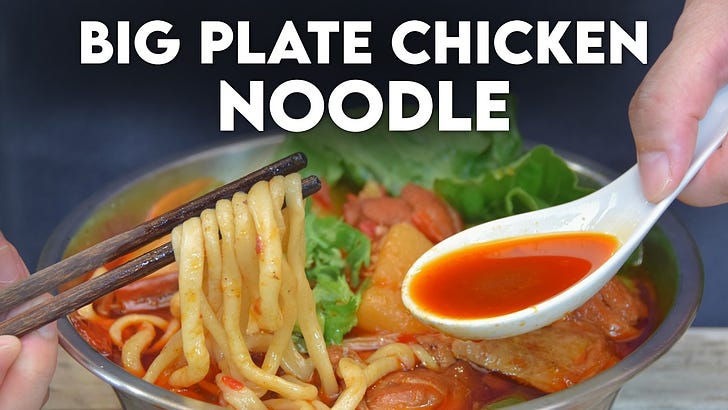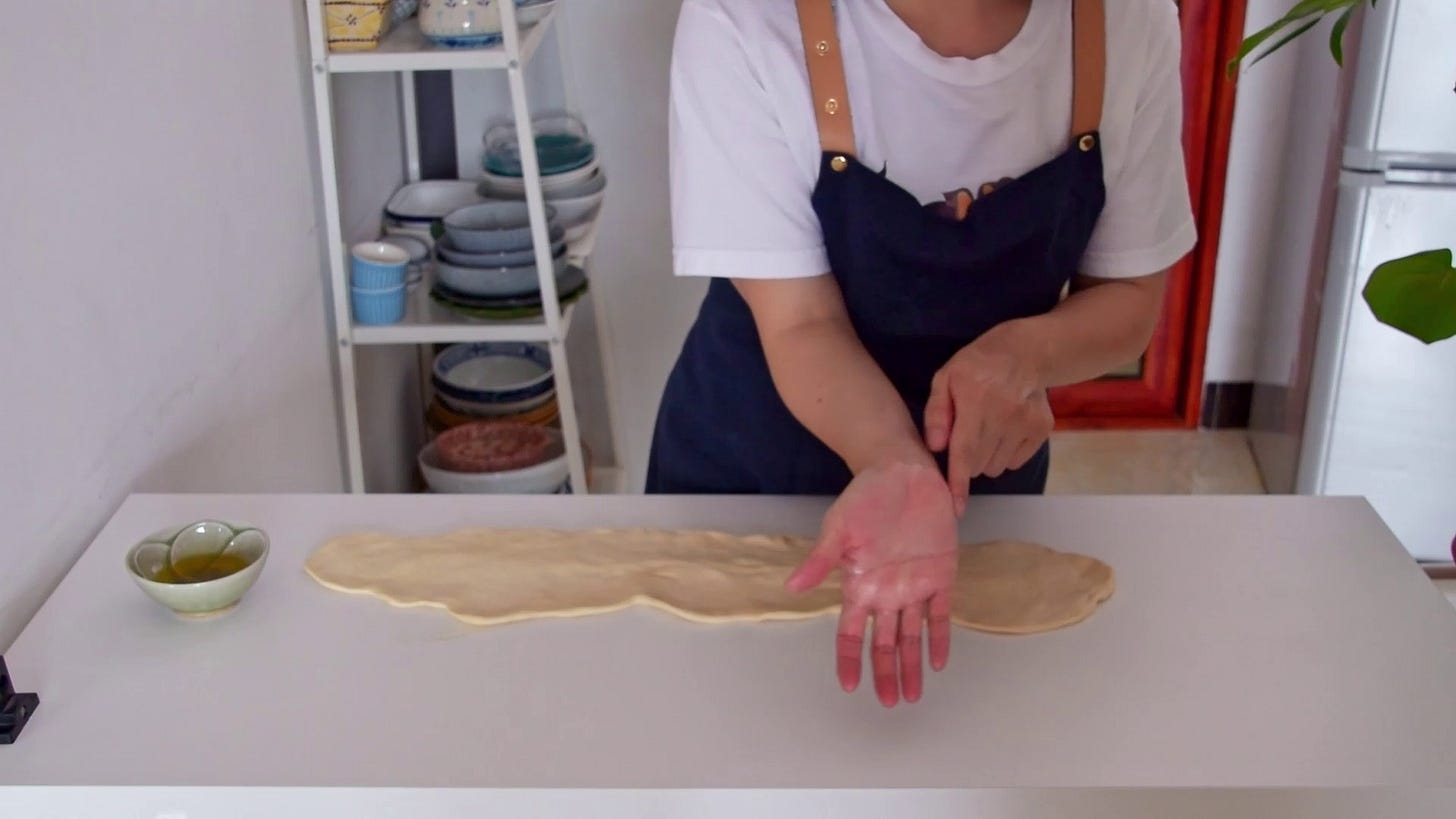Big Plate Chicken Noodle Soup (运城大盘鸡)
A variant of the classic from (interestingly) the Shanxi Province
You’ve probably never heard of the city of Yuncheng, in the Shanxi province. It’s alright, before this video I was also only vaguely aware of the place.
There’s a salt water lake there that’s pretty famous, but besides that, even for a China geography buff it’s very easy for it to bleed into other spots on the North China plain. One of those places defined by other places – a city that’s West of Zhengzhou, a city that’s South of Taiyuan, a city that’s a pit stop on highway 30.
And yet, of course, Yuncheng is still a proper city, a city of 4.7 million people.
Now, whenever you see eye-popping population numbers in a context of a Chinese city… it’s important to remember that a ‘city’ in China is really more like a mini-province. The city proper is a shade under a million – so, less of a Los Angeles or a Berlin, more of a Jacksonville or a Liverpool. And yet I think that’s still quite a bit of weight behind a city that you’ve likely just heard for the very first time.
And food wise? In Yuncheng, they have a soup noodle dish that’s… absolutely incredible. Yuncheng Danpanji, big plate chicken:
What is Shanxi cuisine?
Now, Shanxi food isn’t really a cuisine that gets a lot of play on our channel. In fairness, it’s also a cuisine that doesn’t really get a lot of play in the English language in general. I’ll confess that I’m far from an expert on the topic – the food in the region is a similar North-China-blur for me that the city itself is. I’ve been to Taiyuan a couple times on business, but that’s about it. There’s starch. They’ve got some incredible noodles. Street barbecue is tasty, if the chengguan are cooperative. I mean, especially for the North, we’ve still got so much of the country left to learn…
So me and Steph quite enjoy watching the Chinese travel vlogger A Xing, as he’s from Shaanxi (the next province over), and is quite knowledgeable about food in the North. If you’re not familiar with the channel, I’d massively recommend it – he’s basically the best case scenario when it comes to food travel. Incredibly well researched, well shot, respects the audience, no cringey yummy faces (and these days, English subtitles too!).
In any event, the other day me and Steph were watching his recent video traveling around Shanxi, where he stopped by Yuncheng:
So, the first dish here was… interesting to me. There’s this Xinjiang dish - big plate chicken - that I’d long been slightly confused by. Because like, a lot of Xinjiang fare is stuff like Polo or Naan bread - things with a lot of Central Asian crossover. But Big Plate Chicken quite obviously has a great deal of Han (or Hui?) Chinese influence, and so, the story goes, that the dish was brought to the province relatively recently by Sichuan migrants. But Sichuan province itself doesn’t seem to have much of a direct equivalent - there’s a few dishes that share similar ideas, but… the same could be said of many places around China.
So, I sat there, excitedly watching the video… called Steph over and wondered aloud if perhaps Yuncheng held the answer to this chicken-y puzzle. After all, the Shanxi province is of the the cradles of Han Chinese culture, and culinarily criminally underexplored by the wider food world, us included.
Now, I won’t make you go watch the A Xing video, but the short answer is no - Yuncheng Big Plate Chicken is a quite modern phenomenon. Apparently, it was a truck driver dish - a category of modern food food we’re still getting a grapple on. It was reportedly forged in the early 00s in the town of Ruicheng, which sits right next to the Lianhuo expressway - a major route opened in the late 90s that connected central China with Xinjiang.
In any event, we were sitting there watching the video and just… really started to want the thing. Like, it looks fantastic, right? And Thai Guey Tiew never really scratch that Northern Chinese noodle itch.
Fortunately, while Steph is no Northern grandmother, at least theoretically we can make this food. So after some slapdash research, we resolved to make it the next day.
It was awesome.
So, I dunno, we just had to tell you about it ASAP. We dropped where we were on the schedule, and started testing a recipe.
Make it. It’s good.
The Logistics of Noodle Pulling
Now, of course, one of the reasons it’s just so awesome is because the noodles themselves are Chenmian (抻面) - i.e. homestyle hand pulled noodles.
We covered chenmian in a previous video: “Hand pulled noodles anyone can make”. And while they’re not Lanzhou Lamian (which we still have PTSD over), I should warn you that they’re still not exactly in the ol ‘quick and easy’ category. They take a little warming up to, a little technique, and are probably easiest to sort the day before cooking. So, a couple tips:
First, if you just… don’t feel like the project? Don’t let it hold you back - use whatever noodle you have around, seriously. Some fresh packaged ramen might be tasty, but really, use what you got. Will this dish be more delicious with chenmian? Certainly. But like, during testing I scarfed down some leftovers using a package of instant noodles, and it was still quite delectable.
Second, we do feel like this sort of noodle dish really shines as a two person recipe. If I had to pull the noodles myself and sort the braise, it wouldn’t really be that relaxing of a recipe - respect to all the northern grandmothers that do this on the regular. When me and Steph do this kind of dish, we employ a division of labour that would make a 18th century economist proud: Steph focuses on the starch component, I focus on the dish component. For us, each of the individual tasks roughly hits that level of ‘relaxed weekend dinner/slightly intense weekday dinner’, so if you’ve got some sort cooking buddy too… I do think this recipe is a prime candidate for a little couch co-op.
Ingredients and Sourcing
For the noodles:
AP Flour, preferably Chinese (中筋面粉) -or- Chinese noodle flour, e.g. 塞北雪 -or- 00 Pizza Flour, preferably Caputo; 200g. Okay, so here’s the deal - you can absolutely use the whatever AP flour you have available. We tested this with Bob’s Red Mill (which we can get here), and it works. That said, the very best flour we’ve ever found for pulled noodles is a Chinese brand called Sai Bei Xue - it’s (1) fresh, usually (2) bleached (3) reasonably high gluten and (4) finely, finely milled. Using this flour put the noodle pulling on easy mode. A flour available in the west that behaves very similarly is Caputo Chef Pizza Flour, which ticks all the boxes except the bleaching. Other 00 Pizza flours are pretty good, but don’t seem to be quite as sturdy as Caputo. Lastly, ‘whatever random Chinese AP flour’ you can find at your local Chinese supermarket will also likely perform better than Bob’s Red Mill or whatnot, as it’s bleached and seems to be more finely milled (works roughly as well as a random 00 pizza flour - slightly less extensible, but slightly more sturdy).
Water, 100g.
Salt, 2g.
Oil, a non-insignificant quantity. For coating/submerging-ish the noodles during the long rest.
For the braise:
Chicken leg, ~2 legs. Or about 700g. We’ll be cleaving this across the bone, but you could also use boneless thigh (in which case go for ~500g).
Marinade for the chicken:
Salt, ¼ tsp.
Chicken bouillon powder (鸡粉), ½ tsp.
Sichuan pepper powder (花椒面), ¼ tsp.
White pepper powder, ⅛ tsp.
Soy sauce (生抽), ½ tsp.
Liaojiu a.k.a. Shaoxing wine (料酒/绍酒), ½ tsp.
Oil, to coat, ~1 tbsp.
Chinese leek, a.k.a. Welsh onion (大葱), 1 -or- the white part from five scallions.
Dried chilis, 5g.
Ginger, ~1 inch.
Star anise (八角), optional, 1.
For the tangse caramel:
Oil, 5 tbsp
Rock sugar (冰糖), 40g -or- granulated sugar, ~3 tbsp
Baijiu (白酒) -or- Liaojiu a.k.a. Shaoxing wine (料酒/绍酒), 1 tbsp. For use while frying.
Pixian Doubanjiang, Sichuan Chili Bean Paste (郫县豆瓣酱), 2 tbsp.
Potato, ~300g. Preferably something on the waxier side like a Yukon gold or French fingerling.
Seasoning for the braise:
Chinese 13 spice powder (十三香) -or- five spice powder (五香粉), 1 tbsp.
Sichuan pepper powder (花椒面), ½ tsp.
Salt, 1 tsp.
Chicken bouillon powder (鸡粉), 1 tsp.
Water, 4 cups.
Medium spicy fresh chili pepper, e.g. Italian Long Hots (螺丝椒), 100g. Optional but recommended.
Final seasoning, to taste:
White pepper powder, ¼ tsp
MSG (味精), ¼ tsp
For serving:
Romaine lettuce, ~3 pieces per bowl
Chopped cilantro
Shanxi mature vinegar
Red onion slices
Techniques to Remember
(1) The Chinese Noodle Knead: Making the Abacus String (算盘子)
When for the pulled noodles, it will be helpful to alter your kneading motion slightly. Instead of a stand mixer or whatever you’re used to using, if you can employ a noodle kneading technique called ‘making the abacus string’.
The basic idea is to simply knead by curling the dough onto itself, so that you’re aligning the gluten as you knead. It’s not mandatory but will make your life easier - especially if you’re not working with a fancy flour like Sai Bei Xue or Caputo Chef Pizza flour.
It works like such:
Flatten out the dough:
Use the bottom of the palm of your hand:
Press down, slightly ‘smear’
Curl up ~1 inch
Move over one hand length and do the same motion
Work down the dough
Once you're at the end, cycle on back
Doesn't this look like an abacus string? (not really…)
Fold in half
Punch down, then repeat the whole process for about eight minutes
Don’t obsess over the precision of the movements. Good enough is good enough - just think of it as a slight alternation to whatever kneading motion you usually employ.
(2) The Chenmian Pulling Technique
Feel free to refer to 10:29 in our video for a thorough discussion. Alternatively, we discuss the technique in our previous pulled noodle post as well:
Basically, you just roll the thing out a touch to get it started, then pull. Once you get a little resistance, smack it against your work surface a few times to continue to lengthen it out.
Recipe
Serves two.
Day one, noodle dough preparation:
Dissolve:
2g salt
100g water
and sprinkle bit by bit over
200g flour
combining with a chopstick as you go.
Press the flour into a ball, rest for 30 minutes.
Press the dough into a rectangle-ish shape. Knead for 8-10 minutes, preferably doing so using the ‘making the abacus string’ technique above. Rest for 10 minutes.
Roll into a ~1cm thick rectangle. Cut the rectangle in half, then into ~1 cm wide sticks. These will be your ‘noodle sticks’.
Pour to a plate:
Oil, at least a couple tbsp
And liberally oil the noodles. Cover with plastic wrap, allowing the wrap to cling to the noodles themselves. Let rest in the fridge overnight.
When you begin cooking the next day, remove the noodles from the fridge to allow to come up to roughly room temperature.
Day two, braise preparation:
STOP! Did you remove the noodles from the fridge to get back up to room temperate?
Cleave into ~1.5 inch chunks (2 inch chunks if boneless):
2 large chicken legs or ~500g of boneless chicken thigh
Mix the chicken with:
¼ tsp salt
½ tsp chicken bouillon powder
¼ tsp sichuan pepper powder
⅛ tsp white pepper powder
½ tsp soy sauce
½ tsp Shaoxing wine
Slice into ~1 inch pieces:
One Chinese leek (if using)
Remove stem, slice into 1.5 inch sections:
5g dried chili
Slice:
1 inch ginger
Add the leek (or scallion whites), chilis, and ginger to the chicken together with:
1 star anise (optional)
~1 tbsp oil, to coat
Reserve as you are preparing everything else.
Peel, cut into ~1.5 inch chunks:
300g potato
and rinse the surface starch off under running water. Optionally keep the potato soaked in a bowl with water until you’re ready to use it.
Remove the stem, cut in half, deseed, and cut into ~1.5 inch chunks:
100g fresh green chili
In a bowl or pyrex, combine:
5 tbsp oil
40g rock sugar -or- 3 tbsp granulated sugar
and add it to a cool wok. Over a medium high flame, let the sugar dissolve, settle at the bottom and turn brownish hue (~3 minutes).
Add the chicken together with all the marinade. Fry until the caramel is no longer quite so sticky and the chicken is nicely colored, ~3 minutes. Then swirl in:
1 tbsp Baijiu -or- Shaoxing wine
Mix, then swap the flame to low. Add:
2 tbsp Pixian Doubanjiang, Sichuan Chili Bean Paste
Combine, allow to stain the oil and the chicken. Turn off the heat.
In a separate braising pot, add the (drained, if soaking!) potatoes from above, together with:
1 tbsp 13 spice -or- 5 spice powder
½ tsp Sichuan pepper powder
1 tsp salt
1 tsp chicken bouillon powder
transfer the stir fry to the braising pot, then add:
4 cups water
Brief mix. Bring everything up to a boil and down to a simmer. Then simmer on low with the lid ajar for at least 30 minutes, or up to 45.
Day two, noodle pulling:
Transfer the noodles to a work surface. Pull the noodles according to the noodle pulling method above.
Add the noodles to rapidly boiling water over a high flame. Once the water is boiling again, add ½ cup water. Once boiling again, add another ½ cup water. Once it boils a final time, transfer the noodles to a serving bowl.
Day two, finishing and serving:
The chicken should be done braising at this point. Season to taste. I added another:
¼ tsp white pepper powder
¼ tsp MSG
Then add the sliced green chili peppers from above. Boil for ~30 seconds, then transfer to the table.
In your noodle bowls, nestle in:
Romaine lettuce, ~3 pieces per serving
For the table, also prepare (all are optional):
Chopped cilantro
Red Onion Slices
Shanxi Mature vinegar
Lao Gan Ma chili crisp (very optional)
People at the table can add vinegar and chili to their noodle bowl to taste (we add neither), topping with a big handful of cilantro if they choose. Eat next to some raw onion slices.
















my attempt at 手擀面 last weekend turn out well and i've been researching 大盘鸡 for the past few days and due to try it this weekend to host some friends. 择日不如撞日。
keep up the good work.
btw which of the sai bei xue flours on this page do you guys recommend?
http://www.saibeixue.com/show/ShowCommodityList.htm?stairId=2&secondId=15&commodityType=1